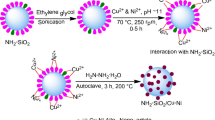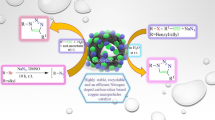Abstract
In this paper, urea group functionalized periodic mesoporous organosilica was utilized as matrix to introduce cobalt precursor into framework. After pyrolysis in nitrogen atmosphere, urea group was decomposed into carbon species and simultaneously the cobalt precursor was reduced to metallic cobalt nanoparticles. The metallic cobalt nanoparticles can be stabilized by coordinating to carbonyl oxygen atoms in carbon species. The supported metallic cobalt exhibited excellent catalytic performance towards 4-nitrophenol hydrogenation reaction. The largest turnover frequency number can reach up to 164.8 h−1, and the reaction rate constant can be as high as 0.77 min−1. The influence of pyrolysis temperature on catalytic performance was also investigated. Compared with the results obtained by samples prepared with wet impregnation method or different pyrolysis rate, it can be concluded that the coordination to carbonyl oxygen atom in carbon species plays a crucial role in improving electron transfer between metallic cobalt and carbon species during catalytic procedure.
Graphic abstract
Metallic cobalt nanoparticles with high dispersion were introduced into urea group functionalized mesoporous silica matrix via pyrolysis in nitrogen atmosphere. The coordination to carbonyl oxygen atom enhances the catalytic performance in 4-nitrophenol hydrogenation.









Similar content being viewed by others
References
Du Z, Chen X, Hu W, Chuang C, Xie S, Hu A, Yan W, Kong X, Wu X, Ji H, Wan LJ (2019) Cobalt in nitrogen-doped graphene as single-atom catalyst for high-sulfur content lithium-sulfur batteries. J Am Chem Soc 141:3977–3985
Zhang Z, Wei X, Yao Y, Chen Z, Zhang A, Li W, Wu WD, Wu Z, Chen XD, Zhao D (2017) Conformal coating of co/n-doped carbon layers into mesoporous silica for highly efficient catalytic dehydrogenation-hydrogenation tandem reactions. Small 13:1702243
Han Y, Wang Z, Xu R, Zhang W, Chen W, Zheng L, Zhang J, Luo J, Wu K, Zhu Y, Chen C, Peng Q, Liu Q, Hu P, Wang D, Li Y (2018) Ordered porous nitrogen-doped carbon matrix with atomically dispersed cobalt sites as an efficient catalyst for dehydrogenation and transfer hydrogenation of n-heterocycles. Angew Chem Int Ed 57:11262–11266
Hong W, Jian C, Wang G, He X, Li J, Cai Q, Wen Z, Liu W (2019) Self-supported nanoporous cobalt phosphosulfate electrodes for efficient hydrogen evolution reaction. Appl Catal B: Environ 251:213–219
Ha NN, Ha NTT, Long NB, Cam LM (2018) Conversion of carbon monoxide into methanol on alumina-supported cobalt catalyst: role of the support and reaction mechanism-a theoretical study. Catalysts 9:6
Cho JM, Ahn CI, Pang C, Bae JW (2015) Fischer-Tropsch synthesis on Co/Al-SBA-15: effects of hydrophilicity of supports on cobalt dispersion and product distributions. Catal Sci Technol 5:3525–3535
Najafabadi AT, Khodadadi AA, Parnian MJ, Mortazavi Y (2016) Atomic layer deposited Co/gamma-Al2O3 catalyst with enhanced cobalt dispersion and fischer-tropsch synthesis activity and selectivity. Appl Catal A-Gen 511:31–46
Grzybek G, Wojcik S, Ciura K, Grybos J, Indyka P, Oszajca M, Stelmachowski P, Witkowski S, Inger M, Wilk M, Kotarba A, Sojka Z (2017) Influence of preparation method on dispersion of cobalt spinel over alumina extrudates and the catalyst deN(2)O activity. Appl Catal B-Environ 210:34–44
Loedolff MJ, Goh BM, Koutsantonis GA, Fuller RO (2018) Supported heterogeneous catalysts: what controls cobalt nanoparticle dispersion on alumina? N J Chem 42:14894–14900
Liu Z, Li J, Buettner M, Ranganathan RV, Uddi M, Wang R (2019) Metal-support interactions in CeO2- and SiO2-supported cobalt catalysts: effect of support morphology, reducibility, and interfacial configuration. ACS Appl Mater Interfaces 11:17035–17049
Dragoi B, Dumitriu E, Guimon C, Auroux A (2009) Acidic and adsorptive properties of SBA-15 modified by aluminum incorporation. Micropor Mesopor Mater 121:7–17
Ghampson IT, Newman C, Kong L, Pier E, Hurley KD, Pollock RA, Walsh BR, Goundie B, Wright J, Wheeler MC, Meulenberg RW, DeSisto WJ, Frederick BG, Austin RN (2010) Effects of pore diameter on particle size, phase, and turnover frequency in mesoporous silica supported cobalt fischer-tropsch catalysts. Appl Catal A: Gen 388:57–67
Zhao Y, Li J, Zhang Y, Chen S, Liew K (2012) Al-SBA-16-supported cobalt catalysts for the fischer-tropsch production of gasoline-fraction hydrocarbons. ChemCatChem 4:1926–1929
Khodakov AY, Zholobenko VL, Bechara R, Durand D (2005) Impact of aqueous impregnation on the long-range ordering and mesoporous structure of cobalt containing MCM-41 and SBA-15 materials. Micropor Mesopor Mater 79:29–39
Munnik P, Jongh PE, Jong KP (2014) Control and impact of the nanoscale distribution of supported cobalt particles used in fischer-tropsch catalysis. J Am Chem Soc 136:7333–7340
Khodakov AY, Constant AG, Bechara R, Villain F (2001) Pore-Size control of cobalt dispersion and reducibility in mesoporous silicas. J Phys Chem B 105:9805–9811
Chen YN, Zhang X, Zhou Z (2019) Carbon-Based substrates for highly dispersed nanoparticle and even single-atom electrocatalysts. Small Methods 11:1900050
Li X, Nisa MU, Chen Y, Li Z (2019) Co-Based catalysts supported on silica and carbon materials: effect of support property on cobalt species and fischer-tropsch synthesis performance. Ind Eng Chem Res 58:3459–3467
Chen Y, Zhu QL, Tsumori N, Xu Q (2015) Immobilizing highly catalytically active noble metal nanoparticles on reduced graphene oxide: a non-noble metal sacrificial approach. J Am Chem Soc 137:106–109
Dhanjai BP, Sinha A, Wu L, Lu X, Tan D, Chen J (2019) Co3O4 nanoparticles supported mesoporous carbon framework interface for glucose biosensing. Talanta 203:112–121
Zhao Y, Liu Y, Du J, Zhang X, Zhou J, Li X, Wu C, Zhu Z, Xie E, Pan X (2019) Facile synthesis of interconnected carbon network decorated with Co3O4 nanoparticles for potential supercapacitor applications. Appl Surf Sci 487:442–451
Wu X, You L, Di B, Hao W, Su M, Gu Y, Shen L (2013) Novel chiral core-shell silica microspheres with trans-(1R, 2R)-diaminocyclohexane bridged in the mesoporous shell: synthesis, characterization and application in high performance liquid chromatography. J chromatogr A 1299:78–84
Benitez M, Bringmann G, Dreyer M, Garcia H, Ihmels H, Waidelich M, Wissel K (2005) Design of a chiral mesoporous silica and Its application as a host for stereoselective Di-π-methane rearrangements. J Org Chem 70:2315–2321
Alvaro M, Ferrer B, García H, Rey F (2012) Photochemical modification of the surface area and tortuosity of a trans-1, 2-bis(4-pyridyl)ethylene periodic mesoporous MCM organosilica. Chem Commun 2002:2012–2013
Wang XG, Lin KSK, Chan JCC, Cheng S (2005) Direct synthesis and catalytic applications of ordered large pore aminopropyl-functionalized SBA-15 mesoporous materials. J Phys Chem B 109:1763–1769
Wang PY, Liu X, Yang J, Yang Y, Zhang L, Yang QH, Li C (2009) Chirally functionalized mesoporous organosilicas with built-in BINAP ligand for asymmetric catalysis. J Mater Chem 19:8009–8014
Moreau JJE, Vellutini L, Man MWC, Bied C (2003) Shape-Controlled Bridged Silsesquioxanes: Hollow Tubes and Spheres. Chem Eur J 9:1594–1599
Chu C, Rao S, Ma Z, Han H (2019) Copper and cobalt nanoparticles doped nitrogen-containing carbon frameworks derived from CuO-encapsulated ZIF-67 as high-efficiency catalyst for hydrogenation of 4-nitrophenol. Appl Catal B: Environ 256:117792
Su Y, Zhu Y, Jiang H, Shen J, Yang X, Zou W, Chen J, Li C (2014) Cobalt nanoparticles embedded in N-doped carbon as an efficient bifunctional electrocatalyst for oxygen reduction and evolution reactions. Nanoscale 6:15080–15089
Xiao H, Fu Z, Chen K, Long Q, Deng Y, Xie K (2016) Preparation of broccoli-like ferromagnetic cobalt microstructures with superior coercivity via an aqueous reduction strategy. RSC Adv 6:66152–66160
Wang LX, Wang L, Meng X, Xiao FS (2019) New Strategies for the preparation of sinter-resistant metal-nanoparticle-based catalysts. Adv Mater 31:1901905
Karthikayini MP, Thirupathi T, Wang G, Ramani VK, Raman RK (2016) Highly active and durable non-precious metal catalyst for the oxygen reduction reaction in acidic medium. J Electrochem Soc 163:F539–F547
Khassin AA, Yurieva TM, Kaichev VV, Bukhtiyarov VI, Budneva AA, Paukshtis EA, Parmon VN (2001) Metal–support interactions in cobalt-aluminum co-precipitated catalysts: XPS and CO adsorption studies. J Mol Catal A: Chem 175:189–204
Liu M, Liu J, Li Z, Wang F (2018) Atomic-Level Co3O4 Layer stabilized by metallic cobalt nanoparticles: a highly active and stable electrocatalyst for oxygen reduction. ACS Appl Mater Interfaces 10:7052–7060
Tabassum H, Mahmood A, Wang Q, Xia W, Liang Z, Qiu B, Zhao R, Zou R (2017) Hierarchical cobalt hydroxide and B/N Co-doped graphene nanohybrids derived from metal-organic frameworks for high energy density asymmetric supercapacitors. Sci Rep 7:43084
Wang M, Han J, Hu Y, Guo R (2017) Mesoporous C, N-codoped TiO2 hybrid shells with enhanced visible light photocatalytic performance. RSC Adv 7:15513–15520
Liu Y, Jiang H, Zhu Y, Yang X, Li C (2016) Transition metals (Fe Co, and Ni) encapsulated in nitrogen-doped carbon nanotubes as bi-functional catalysts for oxygen electrode reactions. J Mater Chem A 4:1694–1701
Dwivedi N, Yeo RJ, Satyanarayana N, Kundu S, Tripathy S, Bhatia CS (2015) Understanding the role of nitrogen in plasma-assisted surface modification of magnetic recording media with and without ultrathin carbon overcoats. Sci Rep 5:7772
Wei Y, Li X, Zhang R, Liu Y, Wang W, Ling Y, El-Toni AM, Zhao D (2016) Periodic mesoporous organosilica nanocubes with ultrahigh surface areas for efficient CO2 adsorption. Sci Rep 6:20769
Bhadra BN, Khan NA, Jhung SH (2019) Co supported on N-doped carbon, derived from bimetallic azolate framework-6: a highly effective oxidative desulfurization catalyst. J Mater Chem A 7:17823–17833
Afedzi T, Yeoh FY, Yang MT, Yip ACK, Lin KYA (2019) A comparative study of hexacyanoferrate-based Prussian blue analogue nanocrystals for catalytic reduction of 4-nitrophenol to 4-aminophenol. Sep Purif Technol 218:138–145
Chen H, Yang M, Tao S, Chen G (2017) Oxygen vacancy enhanced catalytic activity of reduced Co3O4 towards p -nitrophenol reduction. Appl Catal B: Environ 209:648–656
Guo X, Zhang M, Zheng J, Xu J, Hayat T, Alharbi NS, Xi B, Xiong S (2017) Fabrication of Co@SiO2@C/Ni submicrorattles as highly efficient catalysts for 4-nitrophenol reduction. Dalton Trans 46:11598–11607
Liu X, Li X, Qin L, Mu J, Kang SZ (2018) CoO/CoP composite hollow polyhedron: a superior catalyst with dramatic efficiency and stability for the room temperature reduction of 4-nitrophenol. Appl Surf Sci 434:967–974
Miao T, Zheng J, Wang J, Xu J, Alharbi NS, Zhang M (2018) Facile synthesis of metal nanoparticles decorated magnetic hierarchical carbon microtubes with polydopamine-derived carbon layer for catalytic applications. Dalton Trans 47:16578–16586
Bingwa N, Bewana S, Ndolomingo MJ, Mawila N, Mogudi B, Ncube P, Carleschi E, Doyle BP, Haumann M, Meijboom R (2018) Effect of alkali and alkaline earth metal dopants on catalytic activity of mesoporous cobalt oxide evaluated using a model reaction. Appl Catal A: Gen 555:189–195
Wu CH, Lin JT, Lin KA (2018) Magnetic cobaltic nanoparticle-anchored carbon nanocomposite derived from cobalt-dipicolinic acid coordination polymer: an enhanced catalyst for environmental oxidative and reductive reactions. J Colloid Interface Sci 517:124–133
Long Y, Huang Y, Shi X, Xiao L (2018) Structure-, dimension-, and particle size-engineering toward highly efficient supported nanoparticulate metal catalysts. J Mater Chem A 6:18561–18570
Yoon H, Xu A, Sterbinsky GE, Arena DA, Wang Z, Stephens PW, Meng YS, Carroll KJ (2015) In situ non-aqueous nucleation and growth of next generation rare-earth-free permanent magnets. Phys Chem Chem Phys 17:1070–1076
Acknowledgements
This work was financially supported by the National Natural Science Foundation of China (granted number: 51472062) and the Opening Project of key Laboratory of Polyoxometalate Science of Ministry of Education of China. The authors greatly acknowledge the financial support.
Author information
Authors and Affiliations
Corresponding authors
Ethics declarations
Conflicts of interest
There are no conflicts to declare.
Additional information
Handling Editor: Dale Huber.
Publisher's Note
Springer Nature remains neutral with regard to jurisdictional claims in published maps and institutional affiliations.
Electronic supplementary material
Below is the link to the electronic supplementary material.
Rights and permissions
About this article
Cite this article
Huo, H., Jiang, Y., Wang, Z. et al. Carbonyl oxygen-coordinated metallic cobalt nanoparticles anchored on hybrid mesoporous silica matrix to enhance 4-nitrophenol hydrogenation. J Mater Sci 56, 364–379 (2021). https://doi.org/10.1007/s10853-020-05263-5
Received:
Accepted:
Published:
Issue Date:
DOI: https://doi.org/10.1007/s10853-020-05263-5




